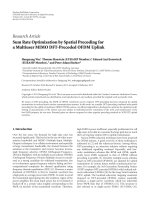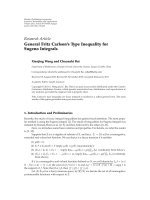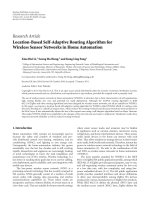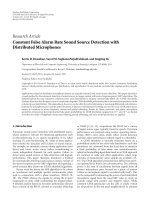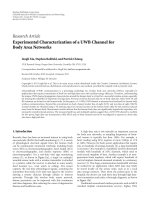Báo cáo hóa học: " Research Article Language Model Adaptation Using Machine-Translated Text for Resource-Deficient Languages" docx
Bạn đang xem bản rút gọn của tài liệu. Xem và tải ngay bản đầy đủ của tài liệu tại đây (601.36 KB, 7 trang )
Hindawi Publishing Corporation
EURASIP Journal on Audio, Speech, and Music Processing
Volume 2008, Article ID 573832, 7 pages
doi:10.1155/2008/573832
Research Article
Language Model Adaptation Using Machine-Translated
Text for Resource-Deficient Languages
Arnar Thor Jensson, Koji Iwano, and S adaoki Furui
Department of Computer Science, Tokyo Institute of Technology, 2-12-1 Ookayama, Meguro-ku, Tokyo 152-8552, Japan
Correspondence should be addressed to Arnar Thor Jensson,
Received 30 April 2008; Revised 25 July 2008; Accepted 29 October 2008
Recommended by Martin Bouchard
Text corpus size is an important issue when building a language model (LM). This is a particularly important issue for
languages where little data is available. This paper introduces an LM adaptation technique to improve an LM built using a small
amount of task-dependent text with the help of a machine-translated text corpus. Icelandic speech recognition experiments were
performed using data, machine translated (MT) from English to Icelandic on a word-by-word and sentence-by-sentence basis. LM
interpolation using the baseline LM and an LM built from either word-by-word or sentence-by-sentence translated text reduced
the word error rate significantly when manually obtained utterances used as a baseline were very sparse.
Copyright © 2008 Arnar Thor Jensson et al. This is an open access article distributed under the Creative Commons Attribution
License, which permits unrestricted use, distribution, and reproduction in any medium, provided the original work is properly
cited.
1. INTRODUCTION
The state-of-the-art speech recognition has advanced greatly
for several languages [1]. Extensive databases both acoustical
and text have been collected in those languages in order
to develop the speech recognition systems. Collection of
large databases requires both time and resources for each
of the target language. More than 6000 living languages are
spoken in the world today. Developing a speech recognition
system for each of these languages seems unimaginable, but
since one language can quickly gain political and economical
importance a quick solution toward developing a speech
recognition system is important.
Since data, for the purpose of developing a speech
recognition system, is sparse or nonexisting for resource-
deficient languages, it may be possible to use data from
the other resource-rich languages, especially when available
target language sentences are limited which often occurs
when developing prototype systems.
Development of speech recognizers for resource-
deficient languages using spoken utterances in a different
language has already been reported in [2], where phonemes
are identified in several different languages and used to
create or aid an acoustic model for the target language. Text
for creating the language model (LM) is on the other hand
assumed to exist in a large quantity and therefore sparseness
of text is not addressed in [2].
Statistical language modeling is well known to be very
important in large vocabulary speech recognition but cre-
ating a robust language model typically requires a large
amount of training text. Therefore it is difficult to create
a statistical LM for resource deficient languages. In our
case, we would like to build an Icelandic speech recognition
dialogue system in the weather information domain. Since
Icelandic is a resource deficient language there is no large
text data available for building a statistical LM, especially for
spontaneous speech.
Methods have been proposed in the literature to improve
statistical language modeling using machine-translated
(MT) text from another source language [3, 4]. A cross-
lingual information retrieval method is used to aid an LM
in different language in [3]. News stories are translated
from a resource-rich language to a resource-sparse language
using a statistical MT system trained on a sentence-aligned
corpus in order to improve the LM used to recognize
similar or the same story in the resource-sparse language.
Another method described in [4]usesideasfromlatent
semantic analysis for cross lingual modeling to develop a
single low-dimensional representation shared by words and
documents in both languages. It uses automatic speech
2 EURASIP Journal on Audio, Speech, and Music Processing
Table 1: Datasets.
Corpus set Sentences Words Unique words
ST 1500 8591 805
SD 300 1870 342
Eval 660 3767 554
recognition transcripts and aligns each with the same or
similar story in another language. Using this parallel corpus
a statistical MT system is trained. The MT system is then
used to translate a text in order to aid the LM used
to recognize the same or similar story in the original
language. LM adaptation with target task machine-translated
text is addressed in [5] but without speech recognition
experiments. A system that uses an automatic speech recog-
nition system for human translators is improved in [6]by
using a statistical machine translation of the source text.
It assumes that the content of the text translated is the
same as in the target text recognized. The above mentioned
systems all use statistical machine translation (MT) often
expensive to obtain and unavailable for resource-deficient
languages.
MT methods other than statistical MT are also available,
such as rule based MT systems. A rule based MT system
can be based on a word-by-word (WBW) translation or
sentence-by-sentence (SBS) translation. WBW translation
only requires a dictionary, already available for many
language pairs, whereas rule based SBS MT needs more
extensive rules and therefore more expensive to obtain. The
WBW approach is expected to be successful only for closely
grammatical related languages. In this paper, we investigate
the effectiveness of WBW and SBS translation methods and
show the amount of data for the resource-deficient language
required to par these methods.
In Section 2, we explain the method for adapting lan-
guage models. Section 3 explains the experimental corpora.
Section 4 explains the experimental setups. Experimental
results are reported in Section 5 followed by a discussion in
Sections 6,and7 concludes the paper.
2. ADAPTATION METHOD
Our method involves adapting a task-dependent LM that is
created from a sparse amount of text using a large translated
text (TRT), where TRT denotes the machine translation of
the rich corpus (RT), preferably in the same domain area
as the task. This involves two steps shown graphically in
Figure 1. First of all the sparse text is split into two, a training
text corpus (ST) and a development text corpus (SD). A
language model LM1 is created from ST,andLM2from
TRT.TheTRT can either be obtained from SBS or WBW
translation. The SD set is used to optimize the weight (λ)
used in Step 2. Step 2 involves interpolating LM1 and LM2
linearly using the following equation:
P
comb
ω
i
| h
=
λ ·P
1
ω
i
| h
+(1−λ)P
2
ω
i
| h
,(1)
where h is the history. P
1
is the probability from LM1 and P
2
is the probability from LM2.
Training set from
the sparse corpus
(ST)
LM1
Development set
from the sparse
corpus
(SD)
Training set from
the rich corpus
(RT)
MT
Translated
training set from
the rich corpus
(TRT)
LM2
Step 1
Compute
weight
Step 2
Combine LM1 and
LM2 and evaluate
the perplexity or
the WER
Eval
Figure 1: Data diagram.
The final perplexity or word error rate (WER) value is
calculated using an evaluation text set or speech evaluation
set (Eval) which is disjoint from all other datasets.
3. EXPERIMENTAL CORPORA
3.1. Experimental data: LM
The weather information domain was chosen for the Ice-
landic experiments and translation from English (rich)to
Icelandic (sparse) using WBW and SBS. For the experiments,
the Jupiter corpus [7] was used. It consists of unique
sentences gathered from actual users’ utterances. A set of
2460 sentences were manually translated from English to
Icelandic and split into ST, SD,andEval sets as shown in
Ta b l e 1 . 63116 sentences were used as RT.
A unique word list was made out of the Jupiter corpus,
and was machine translated using [8] in order to create a
dictionary. This MT is a rule-based system. The dictionary
consists of one-to-one mapping, that is, an original English
word has only one Icelandic translation. The word transla-
tion can consist of zero (unable to translate), one, or multiple
words. Multiple words occur in the case when a word in
English cannot be described in one word in Icelandic such
that the English word “today” translates to the Icelandic
words “dag.” An English word is usually translated to one
Icelandic word only.
ArnarThorJenssonetal. 3
Table 2: Translated datasets.
Corpus set Sentences Words Unique words
TRT
WBW
62962 440347 3396
TRT
SBS
62996 406814 7312
Table 3: BLEU evaluation of the SBS and the WBW machine trans-
lators.
Translation
method
BLEU
1-gram 2-gram 3-gram 4-gram Average
WBW
0.47 0.28 0.19 0.15 0.27
SBS
0.58 0.42 0.32 0.26 0.39
Table 4: Icelandic phonemes in IPA format.
Vo ve l / i,i,ε,a,y,œ,u, ,au,ou,ei,ai,œy/
Consonant / p, p
h
,t,t
h
,c,c
h
,f,v,ð,s, ,ç, ,m,n,l,r/
The dictionary was then used to translate RT WBW
into TRT
WBW
. Another translation TRT
SBS
was created by
SBS machine translation using [8]. Names of places were
identified and then replaced randomly with Icelandic place
names for both TRT
WBW
and TRT
SBS
,sincethetaskisinthe
weather information domain. Ta b l e 2 shows some attributes
of the WBW and SBS translated Jupiter texts. The reason
why the number of sentences in Ta b le 2 does not match the
number of sentences found in the RT set is because of empty
translations. The reason why the unique words in Ta b l e 2
are more than double for TRT
SBS
compared to TRT
WBW
is
because Icelandic is a highly inflected language and the SBS
translation system can cope with those kinds of words as well
as word tenses and words articles to some extent whereas the
WBW translation system copes poorly.
A 1-gram, 2-gram, 3-gram, and 4-gram translation
evaluation using BLEU [9] was performed on 100 sentences
created from both the SBS and the WBW machine transla-
tors, using two human references. Ta b l e 3 shows the BLEU
evaluation results. The SBS machine translation outbeats
the simple WBW translation as expected. It is a known
fact that even human translators do not get full mark (1.0)
using the BLEU evaluation [9]. The evaluation still results in
0.15 and 0.26 for WBW and SBS, respectively, using 4-gram
evaluation.
3.2. Experimental data: acoustic model
A biphonetically balanced (PB) Icelandic text corpus was
used to create an acoustic training corpus. A text-to-
phoneme translation dictionary was created for this purpose
based on [10] using 257 pronunciation rules. The whole
set of 30 Icelandic phonemes used to create the corpus,
consisting of 13 vowels and 17 consonants, are listed in IPA
format in Ta b l e 4 .
Some attributes of the PB corpus are given in Tab l e 5 .
The acoustic training corpus was then recorded in a clean
environment to minimize external noise. Tab l e 6 describes
some attributes of the acoustic training corpus.
Table 5: Some attributes of the phonetically balanced Icelandic text
corpus.
Attribute Text corpus
No. of sentences 290
No. of words 1375
No. of phones 8407
PB unit Biphone
No. of unique PB units 916
Average no. of words/sentence 4.7
Average no. of phones/word 6.1
Table 6: Some attributes of the Icelandic acoustic training corpus.
Attribute Acoustic corpus
No. of male speakers 13
No. of female speakers 7
Time (hours) 3.8
Table 7: Some attributes of the Icelandic evaluation speech corpus.
Attribute Evaluation speech corpus
No. of utterances 4000
No. of male speakers 10
No. of female speakers 10
Time (hours) 2.0
Table 8: Experimental setup.
Experiment no. TRT corpus Vocabulary
Experiment 1 None V
ST
Experiment 2 None V
ST
+ V
TRT
WBW
Experiment 3 TRT
WBW
V
ST
Experiment 4 TRT
WBW
V
ST
+ V
TRT
WBW
Experiment 5 None V
ST
+ V
TRT
SBS
Experiment 6 TRT
SBS
V
ST
Experiment 7 TRT
SBS
V
ST
+ V
TRT
SBS
Experiment 8 TRT
WBW
+ TRT
SBS
V
ST
+ V
TRT
WBW
+ V
TRT
SBS
25-dimensional feature vectors consisting of 12 MFCCs,
their delta, and a delta energy were used to train gender-
independent acoustic model. Phones were represented as
context-dependent, 3-state, left-to-right hidden Markov
models (HMMs). The HMM states were clustered by a
phonetic decision tree. The number of leaves was 1000. Each
state of the HMMs was modeled by 16 Gaussian mixtures.
No special tone information was incorporated. HTK [11]
version 3.2 was used to train the acoustic model.
3.3. Evaluation speech corpus
An evaluation corpus was recorded using sentences from
the previously explained Eval set. There were 660 sentences
in total but divided into sets of 220 sentences for each
speaker, overlapping every 110 sentences. The final speech
evaluation corpus was stripped down to 200 sentences for
4 EURASIP Journal on Audio, Speech, and Music Processing
32
34
36
38
40
42
44
46
48
50
Wor d e rr or ra te (% )
1 2 3 4 5 6 7 8 9 10 11 12 13 14 15
×10
2
Number of ST sentences
Experiment 1
Experiment 2
Experiment 3
Experiment 4
Figure 2: Word error rate results using the baseline from Experi-
ment 1 and the interpolated WBW machine-translated results from
Experiment 2, Experiment 3, and Experiment 4.
each speaker since several utterances were deemed unusable.
Some attributes of the corpus are presented in Tab l e 7 .None
of the speakers in the evaluation speech corpus is included in
the acoustic training corpus described in Section 3.2.
4. EXPERIMENTAL SETUP
In total, eight different experiments were performed. The
experimental setup can be viewed in Ta b le 8 . Experiment 1
used no translation and its vocabulary consisted only from
the unique words found in the ST set, creating V
ST
,andis
therefore considered as the baseline. Experiments 2 to 4 used
WBW machine-translated data. Experiment 2 used no TRT
corpus but used the unique words found in TRT
WBW
,creat-
ing the vocabulary V
TRT
WBW
. This was done in order to find
the impact of including only WBW translated vocabulary.
Experiment 3 used the WBW machine-translated corpus
along with the V
ST
vocabulary. Experiment 4 used the WBW
MT along with the combined vocabulary from the ST and
TRT corpora.
Experiments 5 to 8 used SBS machine-translated data.
Experiment 5 used no TRT corpus but used the unique
words found in TRT
SBS
,creatingthevocabularyV
TRT
SBS
.
This was done in order to find the impact of including
only SBS translated vocabulary. Experiment 6 used TRT
SBS
as the TRT corpus without adding translated words to the
vocabulary. Experiment 7 used the SBS MT along with the
combined vocabulary found from the ST and TRT corpora.
Experiment 8 used both information from the SBS and
WBW MT. Using WBW translated data along with SBS MT
canbedonesincethedictionaryusedtocreatetheWBWMT
was created using the SBS MT.
The ST set size varied from 100 to 1500 sentences for all
the experiments. In the following text ST
n
corresponds to
32
34
36
38
40
42
44
46
48
50
Wor d e rr or ra te (% )
1 2 3 4 5 6 7 8 9 10 11 12 13 14 15
×10
2
Number of ST sentences
Experiment 1
Experiment 5
Experiment 6
Experiment 7
Experiment 8
Figure 3: Word error rate results using the baseline from Experi-
ment 1 and the interpolated SBS machine-translated results from
Experiment 5, Experiment 6, Experiment 7, and Experiment 8.
asubsetoftheST set where n is the number of sentences
used. Experiments with no ST set included, ST
0
, was also
performed on Experiment 4, Experiment 7, and Experiments
8. All LMs were built using 3-grams with Kneser-Ney
smoothing. The WER experiments were performed three
times with different, randomly chosen sentences, creating
each ST and SD set, in order to increase the accuracy
of the results. An average WER was calculated over the
three experiments. This increases accuracy when comparing
different experiments especially when the ST set is very
sparse. The vocabulary changed for each ST and SD set and
the values for words and unique words in Tab l e 1 reflect only
one of the three cases. The words and vocabulary sizes for
the other two cases were very similar to the one reported
in Ta b l e 1 . Perplexity and out-of-vocabulary (OOV)results
reported in this paper also correspond only to the case with
ST and SD sets found in Ta b l e 1. Each experiment had the
interpolation weights optimized on the SD corpus.
The speech recognition experiments were performed
using Julius [12] version “rev.3.3p3 (fast).”
5. RESULTS
The WER results from Experiment 1, Experiment 2, Exper-
iment 3, and Experiment 4 are shown in Figure 2.Whenno
manual ST sentences are present and only WBW machine-
translated data is used, Experiment 4 gives WER of 67.6%.
When 100 ST sentences are used in Experiment 1, the
WER baseline is 49.6%. Experiment 4 reduces the WER
to 46.6% when adding the same number of ST sentences.
As more ST sentences are added, the improvement in
Experiment 4 reduces and converges with the baseline when
500 ST sentences are added to the system. Experiment 2 and
Experiment 3 give a small improvement over the baseline
ArnarThorJenssonetal. 5
Table 9: Perplexity results.
ST
n
Experiment no. ST
0
ST
100
ST
500
ST
1000
ST
1500
Experiment 1 NA 30.7 26.4 26.3 26.5
Experiment 3 NA 29.4 26.0 26.1 26.3
Experiment 6 NA 26.6 25.3 25.3 25.4
Experiment 2 NA 58.2 34.2 31.9 30.8
Experiment 4 664.6 50.2 32.6 30.7 29.9
Experiment 5 NA 88.9 43.5 37.7 35.3
Experiment 7 287.0 61.1 38.4 34.1 32.5
Experiment 8 274.8 61.6 38.5 34.4 32.6
Table 10: OOV rate (%) with corresponding vocabulary sizes inside parentheses.
ST
n
Vo ca b ula r y ST
0
ST
100
ST
500
ST
1000
ST
1500
V
ST
n
NA 14.0 6.8 5.5 4.6
(0) (190) (451) (614) (805)
V
ST
n
+ V
TRT
WBW
26.8 8.4 4.8 4.0 3.4
(3396) (3501) (3638) (3755) (3911)
V
ST
n
+ V
TRT
SBS
9.2 4.4 2.6 2.5 2.2
(7312) (7353) (7432) (7500) (7597)
V
ST
n
+ V
TRT
WBW
+ V
TRT
SBS
9.0 4.4 2.6 2.4 2.2
(8432) (8470) (8546) (8613) (8707)
when the ST set is small but converges quickly as more ST
sentences are added.
The WER results from Experiment 5, Experiment 6,
Experiment 7, and Experiment 8 along with the baseline in
Experiment 1, are shown in Figure 3.WhennoST sentences
are present and only SBS or SBS and WBW machine-
translated data is used, Experiment 7 and Experiment 8
give WER of 56.5% and 56.8%, respectively. When 100 ST
sentences are added to the system and interpolated with the
TRT corpus in Experiment 7, the WER is 41.9%. Experiment
8 gives a 42.0% WER when 100 ST sentences are added to
the system. As more ST sentences are added, the relative
improvement reduces. When 1500 ST sentences are used,
the WER in Experiment 7 gives 32.5% compared to 32.7%
when the baseline is used. When the translated vocabulary
is alone added, Experiment 5 does not give any significant
improvement over the baseline. When the vocabulary is
fixed to the ST set and TRT
SBS
is used as the TRT set,
Experiment 6 gives a small improvement over the baseline.
When ST composes of 1500 sentences, the interpolation in
Experiment 6 gives a WER of 32.6%. Each experiment was
performed three times with different ST and SD set, and the
average WER calculated, as explained before. For example,
Experiment 7 shown in Figure 3 gives WER 41.8%, 41.9%,
and 42.1%, with an average of 41.9%, when 100 ST sentences
are used.
When the WER results are more carefully investigated
we are able to find out how many more ST sentences are
needed for Experiment 1 to par Experiment 7. When 100
ST sentences are used for Experiment 7 then around 150 ST
sentences in addition are needed for Experiment 1 to par
the WER result of Experiment 7. When 500 ST sentences
are used for Experiment 7 then around 300 ST sentences
in addition are needed for Experiment 1 to par the WER
results. When 1000 ST sentences are used for Experiment
7 then around 200 ST sentences in addition are needed for
Experiment 1 to par the WER results in Experiment 7.
Perplexity and OOV results are shown in Tables 9
and 10, respectively, for some ST values. The perplexity
results for Experiment 1, Experiment 3, and Experiment
6 should be compared together since the vocabulary is
the same for those experiments, V
ST
. Experiment 2 and
Experiment 4 have the same vocabulary, V
ST
combined with
V
TRT
WBW
and should be compared together. For the same
reason Experiment 5 and Experiment 7 should be compared
together having the same vocabulary, V
ST
combined with
V
TRT
SBS
.AsshowninTa b l e 9, all perplexity results get
improved when a TRT corpus is introduced and interpolated
with the corresponding ST set. The OOV rate shown in
Ta b l e 1 0 is reduced by adding the unique words found in the
TRT set to V
ST
as expected. When the system corresponds
to 100 ST sentences, the OOV rate is reduced from 14.0%
to either 8.4% or 4.4% using WBW or SBS MT, respectively.
Not applicable (NA) are displayed in Tables 9 and 10 for
experiments that have no ST sentences and are based solely
on the V
ST
vocabulary and/or are not using any TRT
corpus, and therefore do not have data to carry out the
experiment.
6 EURASIP Journal on Audio, Speech, and Music Processing
6. DISCUSSION
The improvement of the Icelandic LM with translated
English text/data was confirmed by reduction in WER by
using either WBW or SBS MT. Experiment 1 should be
compared with the other experiments since Experiment 1
does not assume any foreign translation. When the baseline
in Experiment 1 is compared with the interpolated results
using WBW MT in Experiment 4, we get a WER 49.6%
reduced to 46.6% respectfully, a 6.0% relative improvement
when using 100 ST sentences. The relative improvement
reduces as more ST sentences are added to the system and
converges to the baseline when 500 ST sentences are added
to the system. Neither Experiment 2 nor Experiment 3 gives
any significant improvement over the baseline. This along
with the results in Experiment 4 suggests that when WBW
translated data is available, both the translated corpus and
its vocabulary should be added to the system when the ST
sentences are sparse.
The reason why Experiment 8 is not outperforming
Experiment 7 is most likely because Experiment 8 is using
unique words found in the TRT
WBW
corpus in addition
to the unique words found in Experiment 7. As Ta b l e 1 0
shows, around 1100 new words are added to the vocabulary
in Experiment 8 compared to Experiment 7 for all ST set
conditions without reducing the OOV rate significantly.
Therefore the perplexity rate increases making the speech
recognition process more difficult. The unique words found
in TRT
WBW
are therefore not contributing toward better
results if vocabulary from TRT
SBS
is used.
When the baseline is compared with the interpolated
results using SBS MT in Experiment 7, we get a WER
49.6% reduced to 41.9% respectfully, a 15.5% relative
improvement when 100 ST sentences are added to the
system. Improvements by merging the vocabulary from the
TRT
SBS
and V
ST
is confirmed by comparing Experiment 6
and Experiment 7 for all ST sets. The WER improvement of
the SBS MT over the WBW MT is confirmed for all the ST
sets as the BLEU evaluation results in Section 3.1 suggests.
This can be seen by comparing Experiment 4 in Figure 2
with Experiment 7 in Figure 3. The improvement is as well
confirmed with perplexity results when Experiment 3 and
Experiment 6 are compared in Ta b l e 9 . When the vocabulary
is kept the same as in the case of Experiment 1, Experiment 3,
and Experiment 6 the proposed methods always outperform
the baseline perplexity results.
7. CONCLUSIONS
The results presented in this paper show that an LM
can be improved considerably using either WBW or SBS
translation. This especially applies when developing a pro-
totype system where the amount of target domain sentences
is very limited. The effectiveness of the WBW and SBS
translation methods was confirmed for English to Icelandic
for a weather information task. The convergence point of
these methods with the baseline was around 400 and 1500
manually collected sentences for the WBW and the SBS
translation methods respectfully. In order to get significant
improvement, a good (high BLEU score) MT system is
needed. The WBW translation is especially important for
resource-deficient languages that do not have SBS machine
translation tools available. It is believed that a high BLEU
score can be obtained with WBW MT for very closely
related language pairs and between dialects. Confirming the
effectiveness of the WBW and the SBS translation methods
for other language pairs is left as future work, as is applying
the rule based WBW and SBS translation methods to a
larger domain, for example broadcast news. Future work
also involves an investigation of other maximum a posteriori
adaptation methods such as [13] and methods like the ones
described in [14–16] that selects a relevant subset from a
large text collection such as the World Wide Web to aid
sparse target domain. These methods assume that a large text
collection is available in the target language but we would like
to apply these methods to extract sentences from the TRT
corpus. Since the acoustic model is only built from 3.8 hours
of acoustic data which gives rather poor results we would like
to either collect more Icelandic acoustic data or use data from
foreign languages to aid current acoustic modeling.
ACKNOWLEDGMENTS
TheauthorswouldliketothankDr.J.GlassandDr.T.Hazen
at MIT and all the others who have worked on developing
the Jupiter system. They also would like to thank Dr. Edward
W. D. Whittaker for his valuable input. Special thanks to
Stefan Briem for his English to Icelandic machine translation
tool and allowing to use his machine translation results. This
work is supported in part by 21st Century COE Large-Scale
Knowledge Resources Program.
REFERENCES
[1] M. Adda-Decker, “Towards multilingual interoperability in
automatic speech recognition,” Speech Communication,vol.
35, no. 1-2, pp. 5–20, 2001.
[2] T. Schultz and A. Waibel, “Language-independent and
language-adaptive acoustic modeling for speech recognition,”
Speech Communication, vol. 35, no. 1-2, pp. 31–51, 2001.
[3]S.KhudanpurandW.Kim,“Usingcross-languagecues
for story-specific language modeling,” in Proceedings of
the International Conference on Spoken Language Processing
(ICSLP ’02), vol. 1, pp. 513–516, Denver, Colo, USA, Septem-
ber 2002.
[4] W. Kim and S. Khudanpur, “Cross-lingual latent semantic
analysis for language modeling,” in Proceedings of IEEE Inter-
national Conference on Acoustics, Speech, and Signal Processing
(ICASSP ’04), vol. 1, pp. 257–260, Montreal, Canada, May
2004.
[5] H. Nakajima, H. Yamamoto, and T. Watanabe, “Language
model adaptation with additional text generated by machine
translation,” in Proceedings of the 19th International Conference
on Computational Linguistics (COLING ’02), vol. 2, pp. 716–
722, Taipei, Taiwan, August 2002.
[6]M.Paulik,S.Stüker,C.Fügen,T.Schultz,T.Schaaf,and
A. Waibel, “Speech translation enhanced automatic speech
recognition,” in Proceedings of IEEE Work shop on Automatic
ArnarThorJenssonetal. 7
Speech Recognition and Understanding (ASRU ’05), pp. 121–
126, San Juan, Puerto Rico, November-December 2005.
[7]V.Zue,S.Seneff,J.R.Glass,etal.,“JUPITER:atelephone-
based conversational interface for weather information,” IEEE
Transactions on Speech and Audio Processing,vol.8,no.1,pp.
85–96, 2000.
[8] S. Briem, “Machine Translation Tool for Automatic Trans-
lation from English to Icelandic,” Iceland, 2007, http://www
.simnet.is/stbr/.
[9] K. Papineni, S. Roukos, T. Ward, and W. Zhu, “BLEU: a
method for automatic evaluation of machine translation,” in
Proceedings of the 40th Annual Conference of the Association for
Computational Linguistics (ACL ’02), pp. 311–318, Philadel-
phia, Pa, USA, July 2002.
[10] E. Rögnvaldsson, Islensk hljodfraedi, Malvisindastofnun
Haskola Islands, Reykjavik, Iceland, 1989.
[11] S. Young, G. Evermann, T. Hain, et al., “The HTK Book
(Version 3.2.1),” 2002.
[12] A. Lee, T. Kawahara, and K. Shikano, “Julius—an open source
real-time large vocabulary recognition engine,” in Proceedings
of the European Conference on Speech Communication and
Technology (EUROSPEECH ’01), pp. 1691–1694, Aalborg,
Denmark, September 2001.
[13]M.BacchianiandB.Roark,“Unsupervisedlanguagemodel
adaptation,” in Proceedings of IEEE International Conference on
Acoustics, Speech, and Signal Processing (ICASSP ’03),vol.1,
pp. 224–227, Hong Kong, April 2003.
[14] R. Sarikaya, A. Gravano, and Y. Gao, “Rapid language model
development using external resources for new spoken dialog
domains,” in Proceedings of IEEE I nternational Confer ence on
Acoustics, Speech, and Signal Processing (ICASSP ’05),vol.1,
pp. 573–576, Philadelphia, Pa, USA, March 2005.
[15] A. Sethy, P. Georgiou, and S. Narayanan, “Selecting relevant
text subsets from web-data for building topic specific language
models,” in Proceedings of the H uman Language Technology
Conference of the North American Chapter of the Association
of Computational Linguistics (HLT-NAACL ’06), pp. 145–148,
New York, NY, USA, June 2006.
[16] D. Klakow, “Selecting articles from the language model train-
ing corpus,” in Proceedings of IEEE International Conference on
Acoustics, Speech, and Signal Processing (ICASSP ’00),vol.3,
pp. 1695–1698, Istanbul, Turkey, June 2000.



